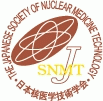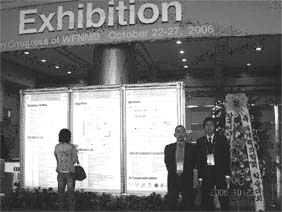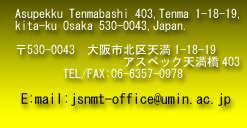---2007:Pusan
---2006:Seoul No.1
---2006:Seoul No.2
---2005:Istanbul
---2004

|
Participating in
the 9th Congress of the World Federation of Nuclear Medicine and Biology (WFNMB)
Hoshi General Hospital
Junichi Tsudzukihashi
The 9th Congress of the World Federation of Nuclear Medicine and Biology
(WFNMB) was held in Seoul, South Korea, from October 22 through 27, 2006.
This congress is held every four years and is attended by a variety of
people working in fields related to nuclear medicine from all over the
world. The number of participants at this congress exceeded 3,000, representing
75 countries and the number oral and poster presentations combined totaled
1,000.

The author along with Mr. Nagaoka in front of the display booth
In order to take part in this large-scale academic congress, the Tohoku Regional Association of the Japanese Society of Nuclear Medicine Technology (JSNMT) planned a four-day and three-night tour, making Sendai Airport the point for departure and arrival. The plan was at first proposed by Mr. Hiroaki Nagaoka, a keen traveler, from the Iwate Medical University Hospital, who serves as the Director in charge of the International Exchange/Personnel Dispatching Committee at JSNMT. Although we were all initially somewhat doubtful about what was proposed by Mr. Nagaoka, his enthusiastic solicitation and aggressive pressure paid off. As a result, four participants signed up for the tour. Finally, the participants came to a total of six: including Mr. Makoto Saito from the Iwate Medical University Hospital, Mr. and Mrs. Hiroaki Nagaoka, Mr. Kazuo Kato from Fukushima Medical University Hospital and Mr. Zokuhashi from the Hoshi General Hospital.
Our departure for Seoul was at noon on October 22 (Sunday). Taking a suitcase and some pocket money that my wife gave me, I headed for Sendai Airport. At the airport, I found myself running into acclaimed Japanese medical doctors, who were in the waiting areas here and there. It reminded me how large and significant this medical congress must be.
The flight from Sendai Airport to Incheon International Airport took about two hours and there is no time difference between Japan and Korea. On our way to the hotel from the airport, we had dinner at a Korean Barbeque restaurant in downtown Seoul. Tired from the trip, we went to bed in preparation for the academic congress beginning from the following day.
On Day Two, the first day of the Congress, it took an unexpectedly long time to check-in to the Congress Hall. When we tried to pay the participation fee in won, they said that only dollars were acceptable and we had to pay by credit card. Furthermore, my handwritten English on the registration card was too difficult for them to make out and I had to re-write it in block letters. After overcoming various problems, we finished registration at long last and managed to go into the display hall, where products from manufacturers the world over were on display in 200 lower booths. Camera equipment manufacturers took, as expected, a large amount of the space. The cyclotrons, measuring instruments and phantoms on display were interesting, but I felt somewhat uncomfortable staying there, because I had difficulty in listening and speaking in English.
Posters were displayed in the back of the display booths and throughout the sessions of the Academic Congress, I felt that there were more lectures on tumor PET study than other subjects. PET seems to be attracting as much attention globally as in Japan. This trend is expected to continue long into the future.
On this day, we attended the luncheon seminar jointly sponsored by Daiichi Radioisotope Laboratories (DRL) and WFNMB, in which JSNMT and KSNMT gave lectures on their respective subjects. As lecturers from Japan who presented in English, we had Chairman Hiroyoshi Fukita speak about the status of nuclear medical tests conducted in Japan in a presentation entitled "The Recent Progress of Nuclear Medicine Technology in Japan and Korea - Outline of the Situation in Japan -." Tetsuro Katabuchi from Gifu University of Medical Science lectured on graphics standardization using an example of myocardial blood flow SPECT graphics titled "Perspective of Nuclear Cardiac Technology" and Mr. Motoo Matsuura of the Osaka Prefectural Saiseikai Noe Hospital lectured on the difference between the two medicines for cerebral blood flow by I-123 identification and the cerebral blood flow statistical analysis software used in Japan in a presentation entitled "Radioactive Traces and Analysis Software in Cerebral Blood Flow Scintigraphy."
There were lectures given by the Korean Society on the status of RI and PET tests and we learnt that the number of medical facilities owning cameras and doing these tests was generally lower in South Korea than in Japan, but they are steadily catching up.
I personally had another objective in making this trip, in addition to attendance at WFNMB. I wanted to inspect universal-type FPDs supplied by a certain manufacturer, because this equipment has not been introduced to Japan yet and the Chief Engineer of our hospital has been expressing interest in it. As that equipment has already been adopted by a certain university hospital in South Korea, we took the liberty of asking said hospital and the supplier to allow us to inspect it. At that university hospital, we had radiological technicians kindly explain about the equipment. Although I won't go into the details of this inspection, making inspection of different facilities was very inspiring, even more so seeing things in different countries. Such inspections would give us perspective into the medical status and progress of radiology in different countries, whether positive or negative. Although we were able to spend only a few hours on this visit, I believe that it was a very informative time thanks to the opportunity that was provided.
On Day Four: we departed from South Korea for Japan during the morning. Our participation at the 9th Congress of WFNMB provided me with valuable experience. Among other things, I was able to realize the level of my English language ability, which was very disappointing to the extent that I seriously thought that I should go to an English conversation school upon returning to Japan. It bought home to me the fact that English language proficiency is one of the minimum requirements to participate in or make presentations at world-class congresses and this has become a personal issue for me to address in order to upgrade my personal skills.
This has been limited to the Tohoku Regional Association of JSNMT this time around. However, it would be much better, if similar events were planned with JSNMT as a whole, because they would enable us to put across the activities of JSNMT to other countries and people in other academic societies and deepen exchanges by acting together with different people. The addition of visits or inspection tours of the programs would make the congresses much more interesting and productive.
The next WFNMB Congress is planned for 2010 in South Africa. If I said to my wife that I might go to South Africa in four years time, she would probably be upset. Personally, however, I am very interested in seeing the state of medicine and nuclear medical tests done in that country firsthand. 2010 will see the FIFA World Cup held in South Africa and hence, South Africa will be heating up in every sense in 2010.
Finally, I want to express my appreciation to the Tohoku Regional Association of JSNMT for giving me this opportunity. My deep personal appreciation also goes to Mr. and Mrs. Makoto Saito, Mr. and Mrs. Hiroaki Nagaoka and Mr. Kazuo Kato for helping me out through the tour. In particular, I wish to express my appreciation to the wives of the members of the participants. They are familiar with making overseas trips and were quite helpful in handling the formalities and chores related to the trip. Last but not least, I am still wondering why I was the only person who was told to open their suitcase by Japanese customs officials at the airport on our way back?
|


